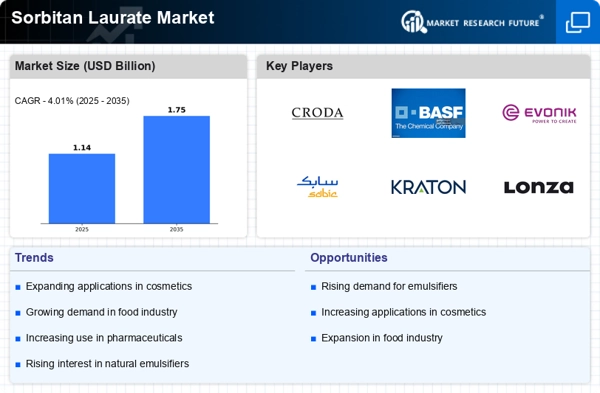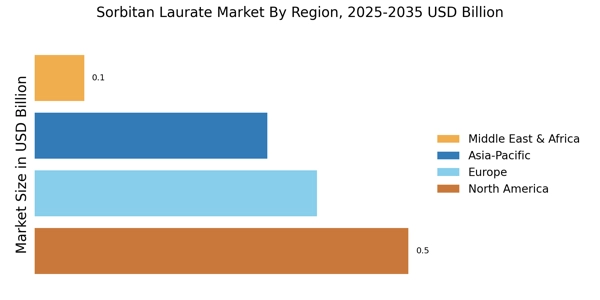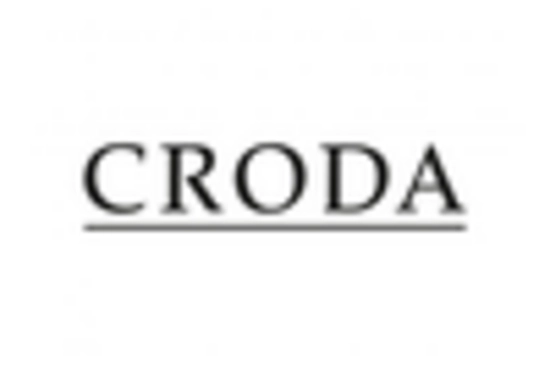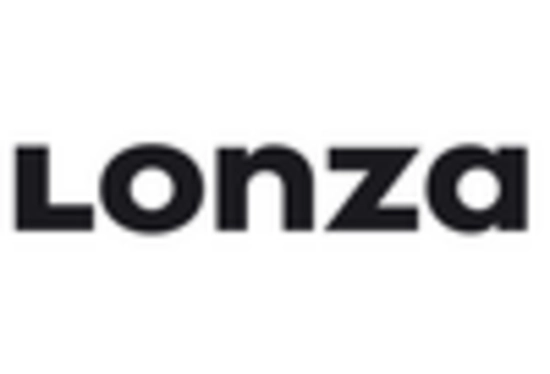Growth in Pharmaceutical Applications
The Sorbitan Laurate Market is also experiencing growth due to its applications in the pharmaceutical sector. This compound is utilized as an emulsifier and solubilizer in various drug formulations, enhancing the bioavailability of active ingredients. The pharmaceutical industry is projected to expand at a CAGR of approximately 6% in the near future, driven by increasing healthcare needs and advancements in drug delivery systems. The ability of Sorbitan Laurate Market to improve the stability and efficacy of pharmaceutical products positions it as a valuable ingredient. As the demand for innovative drug formulations rises, the Sorbitan Laurate Market is expected to see increased adoption in pharmaceutical applications, reflecting the compound's versatility and effectiveness.
Increasing Application in Food Industry
The Sorbitan Laurate Market is experiencing a notable increase in demand due to its extensive application in the food sector. This compound serves as an emulsifier, stabilizer, and thickening agent, which enhances the texture and shelf life of various food products. The food industry is projected to grow at a compound annual growth rate (CAGR) of approximately 4.5% over the next few years, which could further drive the demand for Sorbitan Laurate Market. As consumers increasingly seek products with clean labels and natural ingredients, the use of Sorbitan Laurate Market, derived from sorbitol and lauric acid, aligns well with these trends. This growing preference for quality and safety in food products suggests that the Sorbitan Laurate Market will continue to expand as manufacturers seek to meet consumer expectations.
Rising Demand in Personal Care Products
The Sorbitan Laurate Market is witnessing a surge in demand within the personal care sector. This compound is widely utilized in formulations for creams, lotions, and cosmetics due to its emulsifying properties. The personal care market is anticipated to grow at a CAGR of around 5% in the coming years, driven by increasing consumer awareness regarding skincare and grooming. Sorbitan Laurate Market not only enhances the stability of emulsions but also improves the sensory attributes of products, making it a preferred choice among formulators. As the trend towards natural and organic personal care products continues to gain momentum, the Sorbitan Laurate Market is likely to benefit from this shift, as it is often perceived as a safer alternative to synthetic emulsifiers.
Technological Advancements in Production
Technological advancements in the production of Sorbitan Laurate Market are contributing to the growth of the Sorbitan Laurate Market. Innovations in manufacturing processes have led to improved efficiency and cost-effectiveness, enabling producers to meet the rising demand across various sectors. Enhanced production techniques, such as the use of green chemistry principles, are likely to reduce environmental impact while maintaining product quality. As manufacturers adopt these advanced technologies, the Sorbitan Laurate Market may experience a boost in supply, allowing for greater penetration into diverse applications, including food, personal care, and pharmaceuticals. This trend suggests a promising future for the industry as it adapts to evolving market needs.
Regulatory Support for Natural Emulsifiers
The Sorbitan Laurate Market is benefiting from increasing regulatory support for natural emulsifiers. Governments and regulatory bodies are promoting the use of safe and natural ingredients in food, cosmetics, and pharmaceuticals, which aligns with the properties of Sorbitan Laurate Market. This regulatory environment encourages manufacturers to incorporate Sorbitan Laurate Market into their formulations, as it is often recognized as safe for consumption and application. The trend towards stricter regulations on synthetic additives further enhances the appeal of natural emulsifiers, potentially leading to increased market share for Sorbitan Laurate Market. As the industry adapts to these regulatory changes, the Sorbitan Laurate Market is likely to see sustained growth and innovation.


















Leave a Comment